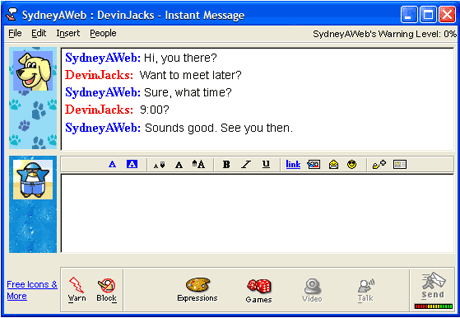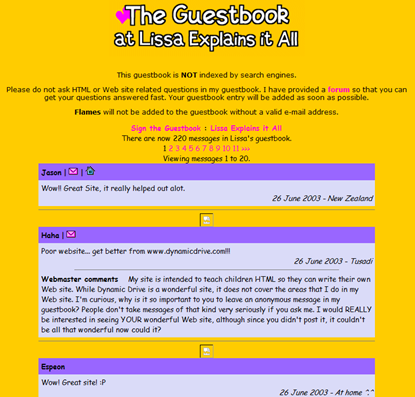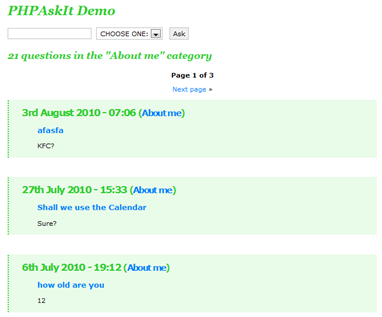There’s no doubt that social media has revolutionised the way we use the Internet, driven by demand for more advanced and varied real-time interaction with others. For some it’s hard to remember what life was like before Facebook; for others the days of AOL 3.0 bring back fond memories. In this post we remember the old days when ISPs dominated the face of the web, how the Internet’s users communicated, and look how original web trends have developed a social media front to open up global communication.
Email (1970s)
One of the web’s communication pioneers, email continues to be extremely popular though it has evolved considerably in terms of functionality and data limits. With a shift away from being ISP-dominated, companies like Google and Microsoft have developed strongholds in the free email account market.
One aspect of email which has declined is the ‘Email to a Friend’ concept – a popular way to encourage page sharing. In this respect email has taken a backseat in favour of social media sites such as Digg and Delicious.
Today’s social media equivalents: Facebook messaging, Twitter direct messaging; Digg and Delicious for ‘email to a friend’ functionality
Chat Rooms (1980s)
Chat rooms have zigzagged in popularity over time. Having once been a primary form of Internet communication, they inherited a bad reputation with the first worries about web safety and topics of discussion.
Many ISPs and community sites offered chat rooms, which were often allocated a particular topic or theme for discussion. Live chat is still often used by commercial sites for customer support or to aid live visitor communication (for example on bingo sites).
Chat rooms have made a small but important transition into social media with the likes of Chatroulette and Tinychat, which have taken advantage of video chat – a big technological step from the original, simple text-based discussion.
Today’s social media equivalents: Chatroulette, Tinychat
Instant Messaging (mid-1990s)
Though it remains extremely popular with the likes of MSN, instant messaging has been around a long time. Notably featured alongside AOL’s email functionality in the 1998 film You’ve Got Mail, instant messaging is still a major form of real-time web communication.
Today’s social media equivalents: Facebook chat, Twitter
Forums (mid-1990s)
Still very popular today, web message boards provided an outlet for people with a shared interest or link to discuss topics in detail. Permanent threads of messages meant that anyone could keep up with the debate at their leisure.
Interestingly, forums have remained relatively unchanged, withstanding the social media explosion. Even social media websites that have adopted the use of discussion boards (such as Facebook) have left them unchanged in terms of functionality, although they tend to remain secondary to feeds, statuses, posts and so on.
Today’s social media equivalent: Facebook discussions
Guestbooks (late 1990s)
Perhaps one of the most important web trends for site owners of the 90s and early 2000s, the guestbook was modelled on the wedding and B&B trend of leaving permanent messages for anyone to read. At one time the only form of visitor interaction for non-forum websites, the guestbook was a valuable tool for website owners to find out what their visitors thought. It was also one way for visitors to roughly measure a site’s popularity.
Guestbooks can be externally hosted (often with adverts) or installed on servers using CGI scripts. Some hosts (like us!) also offer their customers free one-click installs.
Today’s social media equivalents: WordPress’s ‘Wall’ plugin,Facebook’s comment widget on your website, Disqus, displaying feeds on your website
Groups (1990s)
MSN Groups was developed around the late 90s, and provided a space on the Internet for people to create and manage groups around a particular discussion. Each group could have a chat room, message board and other facilities, and groups were also categorised.
The MSN groups service was closed down in February 2009, and replaced with the Windows Live service. Many other companies offer comparable groups functionality, including Yahoo and Google.
Today’s social media equivalent: Facebook groups, MySpace groups
b2 (also Blogger, Movable Type, Greymatter and other blogging clients – early 2000s)
There were many other blogging platforms before WordPress took off, including Movable Type and Greymatter, but I’ve chosen b2 as it’s the forerunner to WordPress.Offering simple blog posts, commenting and smilies, b2 contained only a tiny amount of the functionality and customisation that WordPress now offers. Furthermore, it had to compete in a competitive market with several other options on offer for bloggers.
See b2 in action at cafelog.com.
If you can imagine WordPress without the framework – no plugins, easily uploadable themes or easy-use template system – then that’s pretty much what b2 was like. Visual customisation had to be done via code writing and editing, and only publicised ‘hacks’ and tutorials offered any in-depth level of customisation unless you were an advanced developer.
Blog commenting was one of the most important facilities for website owners who had previously just relied on guestbooks (or forums) for communication. This sparked a whole new era of interaction and discussion from individuals and personal websites.
Today’s social media equivalents: Tumblr, Facebook notes (both are overshadowed by WordPress) and Disqus
Tagboards (early 2000s)
Still occasionally seen on smaller personal websites, tagboards were a compromise between commenting and guestbooks. Also known as the ‘Shoutbox’ or ‘Chatterbox’, they were often used to leave general comments or questions about a site, but had the advantage of being in the sidebar or index page rather than several clicks away like a guestbook.
Messages weren’t permanently stored, and several sites offered free tagboard hosting. Customisable CGI installs were also available for those who wanted to self-host. Popular in the teen communities, they began to attract a lot of spam messages and eventually dropped out of the ‘web trend’ list.
Today’s social media equivalent: Facebook Wall
Interactive Whiteboards (mid-2000s)
More of a niche fad, interactive whiteboards allowed visitors to create and store images for other visitors and the website owner to view. The quality of the drawings varied wildly from wobbly doodles to illustrated masterpieces. If you were using the whiteboard at the same time as someone else, you could take advantage of the built-in chat functionality to communicate in real-time.
These days, whiteboards like dabbleboard.com offer joint collaboration and are generally only used by online tutors and some business users rather than the wider web community.
Today’s social media equivalent: No real social media equivalent – Facebook whiteboard apps are available.
Q & A (developed versions from mid-2000s)
Starting out as simple FAQ pages, asking questions on the web became more sophisticated with contact forms and PHP scripts. These outlets improved Internet communication substantially as rather than generic or assumed questions, individuals could ask specific questions and receive a direct response which could be valuable to others as well.
A useful way to stop the same questions being asked repeatedly by site visitors, the traditional FAQ has expanded into social media in a few different ways. Yahoo Answers adopted an information-sharing approach, with users encouraged to ask and answer practical questions. Formspring.me lets users sign up for an account, for the purpose of their friends and visitors asking them questions. The newest addition to this area is Facebook’s Questions, with a similar purpose to Yahoo Answers as an advice-giving and information-sharing service.
Today’s social media equivalents: Formspring.me, Facebook Questions, Yahoo Answers
Summary
Most forms of web communication have proved surprisingly adaptable to the web’s new social media ecosystem and continue to thrive and develop. Guestbooks have almost completely died out but could see a revamp with the increasing popularity of wedding and memorial websites. Forums have escaped the demands of social media and remain relatively unchanged – for now…
Facebook has adopted a surprising number of these original forms of communication; perhaps that’s one factor in its overwhelming success.
It’s been a snowballing forty years of development in web communication trends – where will we be in the next forty?!










Comments
Please remember that all comments are moderated and any links you paste in your comment will remain as plain text. If your comment looks like spam it will be deleted. We're looking forward to answering your questions and hearing your comments and opinions!